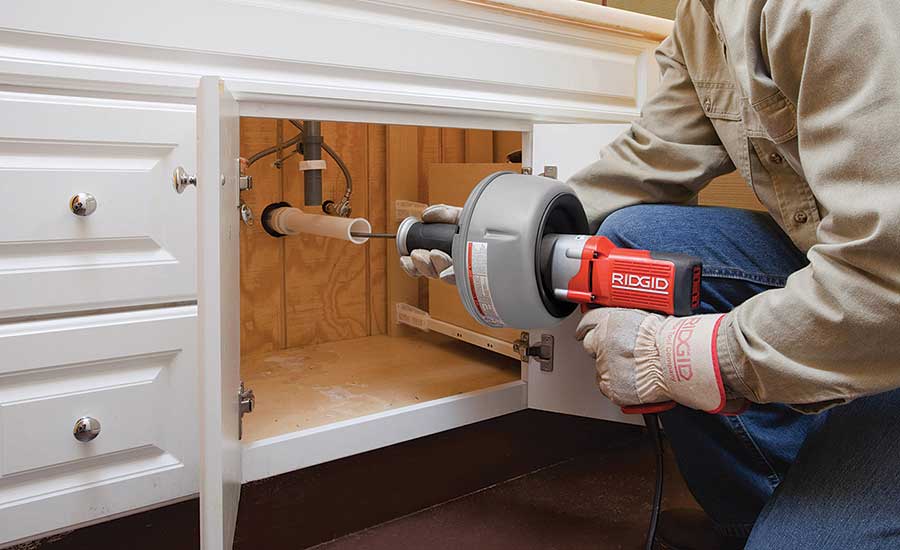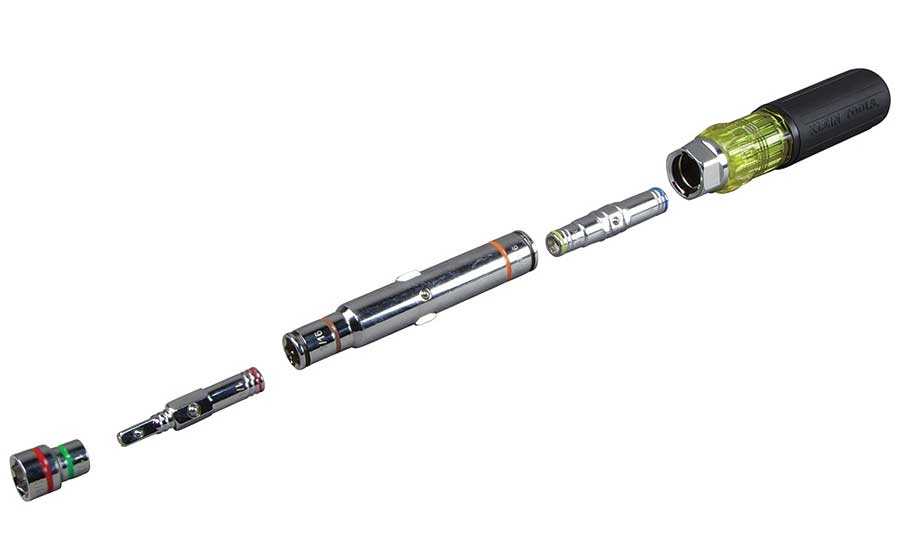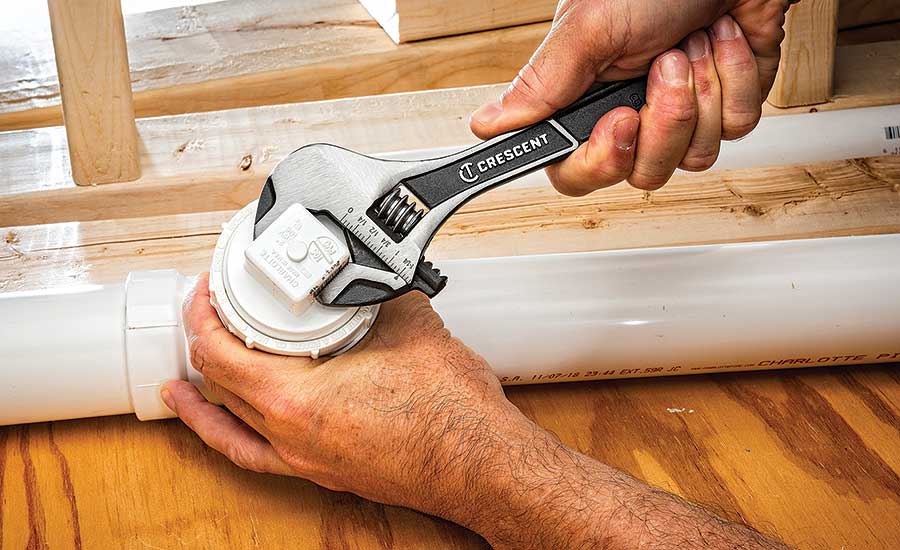Smaller, faster, lighter tools shape plumbing market
Tool manufacturers help plumbers get the job done quicker, with less fatigue.

The RIDGID K-45 Sink Machine is purpose-built for small drain line cleaning, including clogged lavatories, sink lines, urinals and tub or shower drains. It is lightweight, easy-to-use and features advanced two-way AUTOFEED control to keep hands and work area clean, advancing and retrieving cable with the push of a lever. Photo credit: RIDGID

Photo credit: Klein Tools

Hilti’s NPR 32-A22 crimps a variety of fittings together rather than using translational methods to join tubing or pipes. The rotating head and built in LED light make it a reliable and efficient solution for your mechanical projects. Photo credit: Hilti North America

Crescent Wide Jaw adjustable wrenches are designed for access and versatility with extra-large jaw capacity. Designed to perform to the strength requirements of the next size up wrench. Photo credit: Crescent Tools

Milwaukee Tool’s 2-1/2” – 4” IPS XL Ring Kit fits directly in the M18 FORCE LOGIC Long Throw Press Tools and gives it the ability to press Viega MegaPress XL Fittings without the use of cumbersome tool extensions, while vastly expanding the range of applications the tool can accomplish. PHOTO CREDIT: MILWAUKEE TOOL

Through its 3-length adaptable design, Milwaukee Tool’s Cheater pipe wrench gives users ultimate versatility on jobs that previously required multiple sizes of traditional pipe wrenches. PHOTO CREDIT: MILWAUKEE TOOL

Photo credit: Klein Tools







Plumbing and mechanical contractors wouldn’t be able to get the job done without the help of innovative, durable and ergonomic tools of the trade. Each year, tool manufacturers release new or redesigned products to make it easier for contractors to finish the job quickly.
Hand tools
“All hand tools are trending to efficiency — things need to be smaller, lighter, faster,” says Brendan Walsh, director of product management for Crescent Tools. “Everybody is trying to get the job done as fast as possible in order to maximize profits.”
Crescent Tools is focused on allowing users to complete the job quickly and efficiently, Walsh notes.
“Take our new Wide Jaw Adjustable wrenches — instead of having to carry two adjustable wrenches, you have one wrench that can do the job of both. The bag’s lighter, you can work faster and it gives you better access and versatility.”
Because plumbers are in and out of different jobs throughout the day, Crescent Tools wants to make it easier to move around, Walsh adds.
“There are a lot of advancements in what plumbers, HVAC techs and electricians are installing,” he says. “The products are smaller, faster and more efficient, so that means tighter spaces. All of that comes into effect when you’re talking about tools in plumbing.”
According to Greg Palese, vice president of marketing, Klein Tools, tradespeople — both young and old — shop for multi-purpose tools to boost productivity.
“Aging tradespeople specifically look to lighten their tool bags and pouches to save wear and tear on their bodies while the younger generation looks for ergonomic tools that can ease strain when used over long work days,” Palese says. “Time and money, including demanding deadlines and limited resources or materials, drive the majority of jobsite trends, but factors like an aging workforce and an increased awareness regarding tool ergonomics are becoming a larger topic in tool design discussions.”
Every plumber in the field is looking for a way to get the job done more efficiently, says Brian Doyle, group product manager, Milwaukee Tool.
“It’s not just about having the fastest tool, it’s also about having a durable tool and a tool that doesn’t fatigue you,” he says. “It’s a combination of all those. A tool needs to last longer and be able to perform the tasks that three tools used to do. The cost of labor is going up and people want to get to more jobs more quickly. If you look at these one-man, two-man shops, they can get jobs done in an hour when it used to take them three hours by using multi-functional tools. That means there’s two more jobs they can get to in a day. It’s about money, but it’s about safety, too.”
Doyle says people are realizing they can no longer modify tools because the Occupational Safety and Health Administration (OSHA) is being more observant of what people do. Milwaukee is addressing some those issues with solutions like its Cheater pipe wrench.
“Users were modifying their pipe wrenches by adding a piece of breaker bar or conduit on the end to get more leverage,” Doyle says. “Our Cheater pipe wrench has three different lengths, which replaces that breaker bar — OSHA didn’t like that breaker bar because you’re modifying a tool. That’s why the Cheater is changing the game for users — it allows you to do more with less.”
Power tools
The trends shaping electric tool design mirror those of hand tools, Palese notes, but with an increased focus on safety as tradespeople become more aware of everyday jobsite hazards.
“Products with extra safety features, including tethering capabilities and insulated tool handles, as well as improved personal protection equipment are in high demand,” he explains.
However, the labor shortage and an aging workforce is probably the largest trend shaping the market, according to Corey Dickert, senior vice president of product management, Milwaukee Tool. Because of such, the entire industry is changing in terms of productivity, mostly because they have no choice in order to keep up with market demand.
“This is driving a number of different technologies, such as the rise of alternative pipe joining methods — moving away from soldering, brazing and welding to things like press and plastic pipe alternatives — things that honestly generate an entirely new tool market with them. A lot of companies are trying to get much more productive in calculating labor productivity.”
One of the ways Milwaukee is increasing productivity is eliminating the need to plug the tool into the wall because the power coming out of the wall limits the tool compared to batteries, Dickert notes.
“The things we’re chasing include never having to lay out extension cords, never having lost time if a scissor lift rolls over a cord or if a tool goes down,” he says. “Battery technology is stretching further than it ever has before. We’re releasing tools that traditionally, people didn’t believe could be cordless, such as a pipe threader or tools that can easily tackle some of the larger pressing applications. You’re lucky if you can drop 30 amps out of a wall plug. With a battery pack, you can determine exactly how you want that power to be used.”
RIDGID has many different considerations when designing tools, but improved ergonomics is becoming more important to all of our designs, notes Brendon Goede, RIDGID Underground Technologies product manager. The pistol grip design is still the most ergonomic for many applications, he says, but RIDGID also offers inline tools, which allow customers to work in locations a pistol grip tool may be unable to access.
“When designing tools that are easy to use, we look into many design aspects that focus on alleviating pain points that exist today,” he says. “A good example is our press tools, we have made the tools lighter, faster and longer lasting between service intervals; all with the goal to make press tools easier to use for our customers. The second focus is on completing a job more efficiently, and in order to do this, we incorporate technologies that do more work in less time. We see productivity improvement technology used on the RIDGID drain cleaning line such as AUTOFEED technology. Products like the K-45 when used with the AUTOFEED are typically able to complete a job more quickly than those without, which frees up a plumber to work on the next job that much sooner.”
Ryan Ramge, mechanical trade manager for Hilti North America, agrees there are a variety of different challenges in the industry around labor and getting things done faster with a tighter workforce. Therefore, the trends he notices center around prefabrication and technology
“We really see customers trying to figure out how they can prefab anything and everything, and then ultimately, how they get BIM and front-end design resources more integrated into workflow,” he says. “We live in a world where the market right now is very strong, so the volume of work is high and the availability of skilled labor is low. When you look at the future of construction, the companies that don’t adapt to new technologies will probably struggle to win the volume of projects they’re accustomed to winning.”
Looking for a reprint of this article?
From high-res PDFs to custom plaques, order your copy today!















